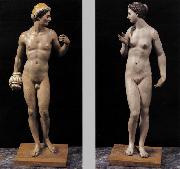La Peinture à l'huile en gros de Chine & Encadre |
|||||||||||

|
|||||||||||
|
|
|
||||||||||||||
|
El Greco
Greek-born Spanish Mannerist Painter, 1541-1614 |
||||||||||||||
|
|
||||||||||||||
|
||||||||||||||
|
|
||||||||||||||
| El Greco
Greek-born Spanish Mannerist Painter, 1541-1614 Epimetheus_and_Pandora 1600s Polychromed wood, height: 43 cm Conde de la Infantas Collection, Granada A few sculptures, including these two strange nudes, have been attributed to El Greco. This attribution is doubtful, however. It is based on the testimony of Pacheco, who saw in El Greco's studio a series of figurines of wax, stucco, and wood, but these may have been merely models, like those used in the Italian workshops where El Greco was trained. The figures illustrated recall certain nudes in paintings by El Greco in their elongated proportions, their supple postures, and their opposition in contrapposto. Nevertheless, they also evoke certain Florentine mannerists, Sansovino or Cellini, and their naturalism and the accentuated musculature of the male figure are surprising for El Greco. The identification of the statuettes is also problematical. Originally thought to represent Adam and Eve or even Vulcan and Venus, they were correctly identified as representing Epimetheus and Pandora in 1961. According to the Greek poet Hesiod, Pandora was the first woman, created from the earth and water. She was brought to life with heavenly fire and married Epimetheus, the brother of Prometheus. Zeus gave her a beautiful box containing all manner of evils and calamities and Pandora or according to some versions of the myth, Epimetheus, opened it, releasing them into the world. These small statuettes are carved in wood and painted in oils, the traditional materials of Spanish polychrome sculpture. They are undocumented works but the attribution to the artist is generally accepted 1600s Polychromed wood, height: 43 cm Conde de la Infantas Collection, Granada A few sculptures, including these two strange nudes, have been attributed to El Greco. This attribution is doubtful, however. It is based on the testimony of Pacheco, who saw in El Greco's studio a series of figurines of wax, stucco, and wood, but these may have been merely models, like those used in the Italian workshops where El Greco was trained. The figures illustrated recall certain nudes in paintings by El Greco in their elongated proportions, their supple postures, and their opposition in contrapposto. Nevertheless, they also evoke certain Florentine mannerists, Sansovino or Cellini, and their naturalism and the accentuated musculature of the male figure are surprising for El Greco. The identification of the statuettes is also problematical. Originally thought to represent Adam and Eve or even Vulcan and Venus, they were correctly identified as representing Epimetheus and Pandora in 1961. According to the Greek poet Hesiod, Pandora was the first woman, created from the earth and water. She was brought to life with heavenly fire and married Epimetheus, the brother of Prometheus. Zeus gave her a beautiful box containing all manner of evils and calamities and Pandora or according to some versions of the myth, Epimetheus, opened it, releasing them into the world. These small statuettes are carved in wood and painted in oils, the traditional materials of Spanish polychrome sculpture. They are undocumented works but the attribution to the artist is generally accepted |
||||||||||||||
|
Related Paintings to El Greco :. |
||||||||||||||
|
|
||||||||||||||
|
|
||||||||||||||
|
CONTACTER DES Etats-Unis |







